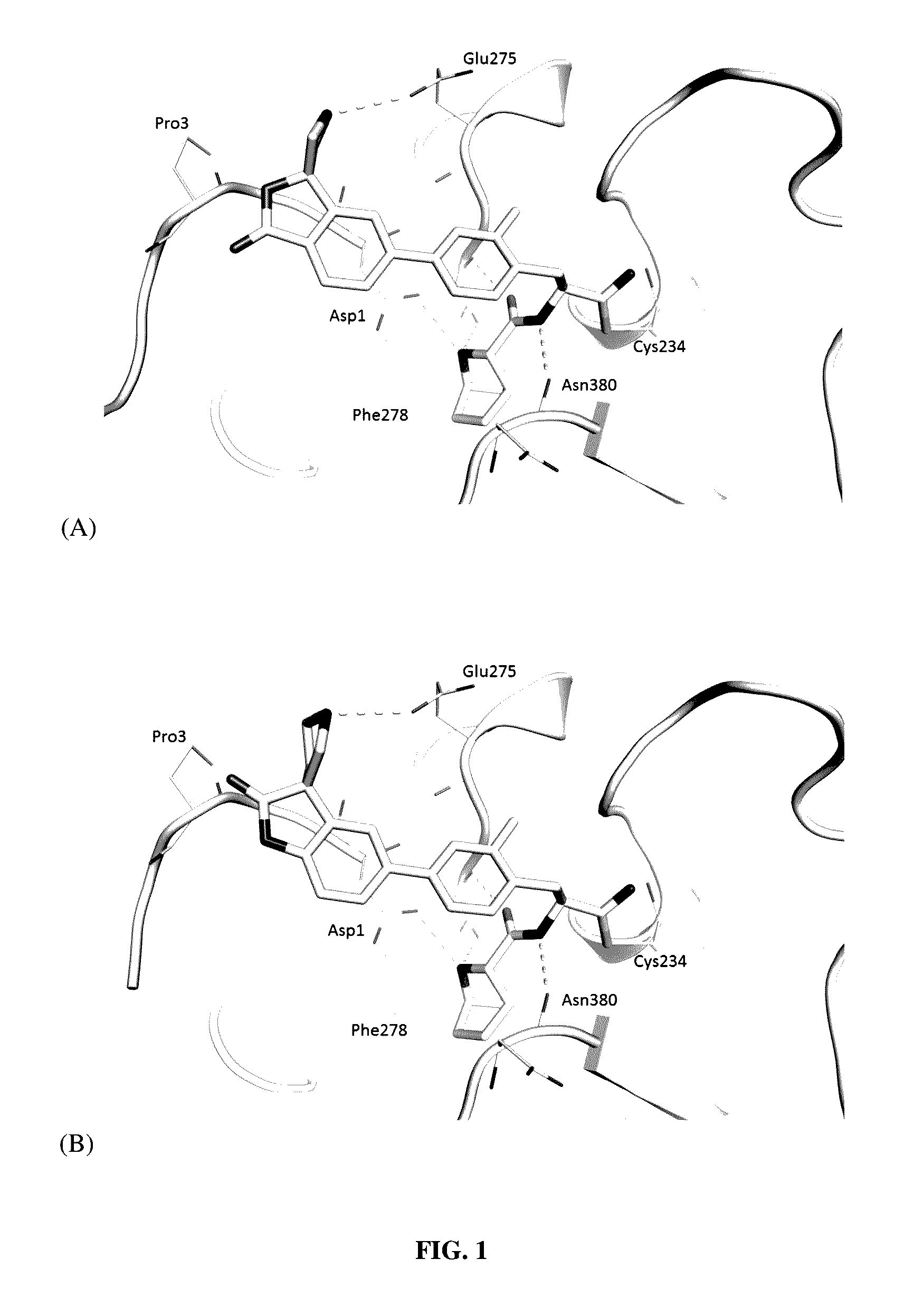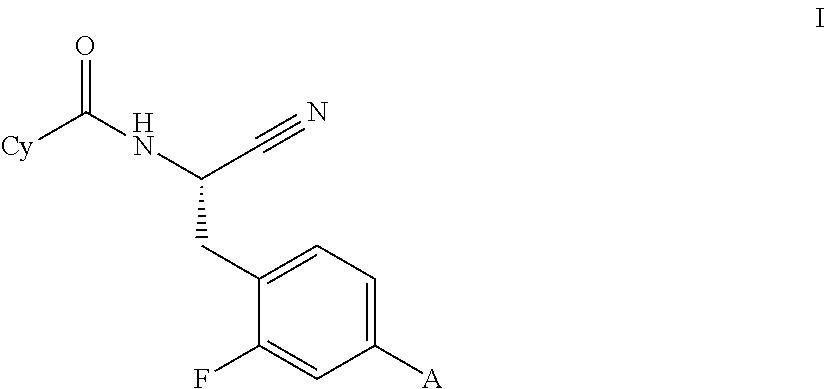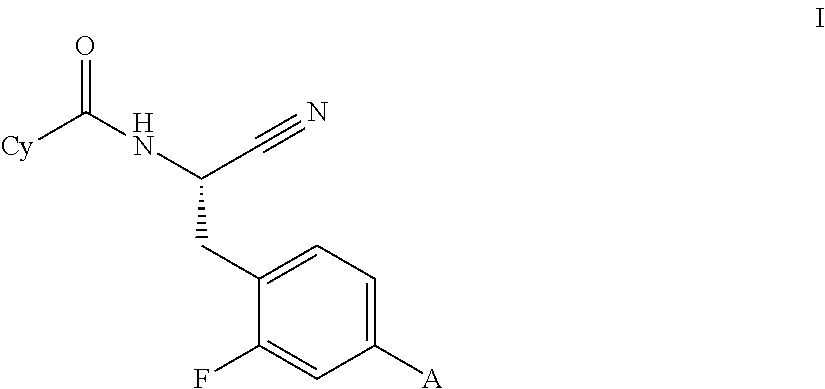Substituted spirocycles
a spirocycle and spirocyclic technology, applied in the field of substitution spirocyclics, can solve the problems of tissue damage and chronic inflammation, and achieve the effect of high inhibition of neutrophil elastase activity
- Summary
- Abstract
- Description
- Claims
- Application Information
AI Technical Summary
Benefits of technology
Problems solved by technology
Method used
Image
Examples
example 1
[0161]
Step 1: Synthesis of Intermediate I-1.1
[0162]To R1 (20.00 g, 55.37 mmol) in dichloromethane (50 mL) is added trifluoroacetic acid (17.09 mL, 221.48 mmol) and the reaction mixture is stirred overnight at r.t. The reaction mixture is concentrated, the residue is dissolved in dichloromethane (15 mL) and diisopropyl ether (140 mL). The precipitate is filtered off, washed with diisopropyl ether and dried to provide I-1.1 as TFA salt.
[0163]Yield 99%, m / z 261 [M+H]+, rt 0.50 min, LC-MS Method Z018_S04.
Step 2: Synthesis of Intermediate I-1.2
[0164]To R2 (13.86 g, 55.72 mmol) in DMF (65 mL) is added DIPEA (9.02 mL, 50.67 mmol) and cooled down to 5° C. TBTU (17.89 g, 55.72 mmol) is added and the reaction mixture is stirred for 15 minutes. Afterwards I-1.1 (TFA salt) (19.0 g, 50.65 mmol), DMF (65 mL) and DIPEA (13.52 mL, 75.98 mmol) are added and the reaction mixture is stirred overnight at r.t. The reaction mixture is diluted with ethyl acetate and extracted with water. The aqueous layer...
example 23
[0181]
Step 1: Synthesis of Intermediate I-1.5.22
[0182]To I-1.4 (92.2 mg, 0.17 mmol) in acetonitrile (3 mL) is added R17 (48.0 mg, 0.17 mmol) and mixture is purged with argon. Caesium carbonate aqueous solution 2 mol / L (171 μL, 0.34 mmol) and 1,1′-bis(di-tert-butylphosphino)ferrocene palladium dichloride (11.1 mg, 0.02 mmol) are added, reaction mixture is purged again with argon and stirred at 80° C. in the microwave reactor for 45 minutes. The reaction mixture is diluted with saturated sodium hydrogen carbonate solution, and extracted with ethyl acetate several times. The organic layer is washed with brine, dried over MgSO4, filtered and concentrated in vacuo. The crude residue is purified by reversed phase HPLC to afford I-1.5.22.
[0183]Yield 52% m / z 632 [M+H]+, rt 1.04 min, LC-MS Method Z011_S03.
Step 2: Synthesis of Example 23
[0184]To I-1.5.22 (56.0 mg, 0.09 mmol) in acetonitrile (2 mL) is added p-toluenesulfonic acid monohydrate (84.3 mg, 0.44 mmol) and reaction mixture is stirred...
example 25
[0186]
Step 1: Synthesis of Intermediate I-1.5.24
[0187]To I-1.4 (2.304 g, 5.34 mmol) in acetonitrile (50 mL) is added R19 (1.50 g, 5.34 mmol) and mixture is purged with argon. Sodium carbonate aqueous solution 2 mol / L (5.343 mL, 10.69 mmol) and 1,1′-bis(di-tert-butylphosphino)ferrocene palladium dichloride (348.2 mg, 0.53 mmol) are added, reaction mixture is purged again with argon and stirred at 70° C. in the microwave reactor for 45 minutes. Additional amount of I-1.4 (150 mg, 0.35 mmol) is added and the reaction mixture is stirred at 70° C. for 25 minutes. The reaction mixture is diluted with saturated sodium hydrogen carbonate solution, and extracted with ethyl acetate several times. The organic layer is washed with brine, dried over MgSO4, filtered and concentrated in vacuo. The crude residue is purified by silica gel column chromatography (DCM:MeOH=99:1 to 9:1) to afford I-1.5.24.
[0188]Yield 55% m / z 632 [M+H]+, rt 1.05 min, LC-MS Method Z011_S03.
Step 2: Synthesis of Example 25
[...
PUM
| Property | Measurement | Unit |
|---|---|---|
| temperature | aaaaa | aaaaa |
| temperature | aaaaa | aaaaa |
| temperature | aaaaa | aaaaa |
Abstract
Description
Claims
Application Information
 Login to View More
Login to View More - R&D
- Intellectual Property
- Life Sciences
- Materials
- Tech Scout
- Unparalleled Data Quality
- Higher Quality Content
- 60% Fewer Hallucinations
Browse by: Latest US Patents, China's latest patents, Technical Efficacy Thesaurus, Application Domain, Technology Topic, Popular Technical Reports.
© 2025 PatSnap. All rights reserved.Legal|Privacy policy|Modern Slavery Act Transparency Statement|Sitemap|About US| Contact US: help@patsnap.com



